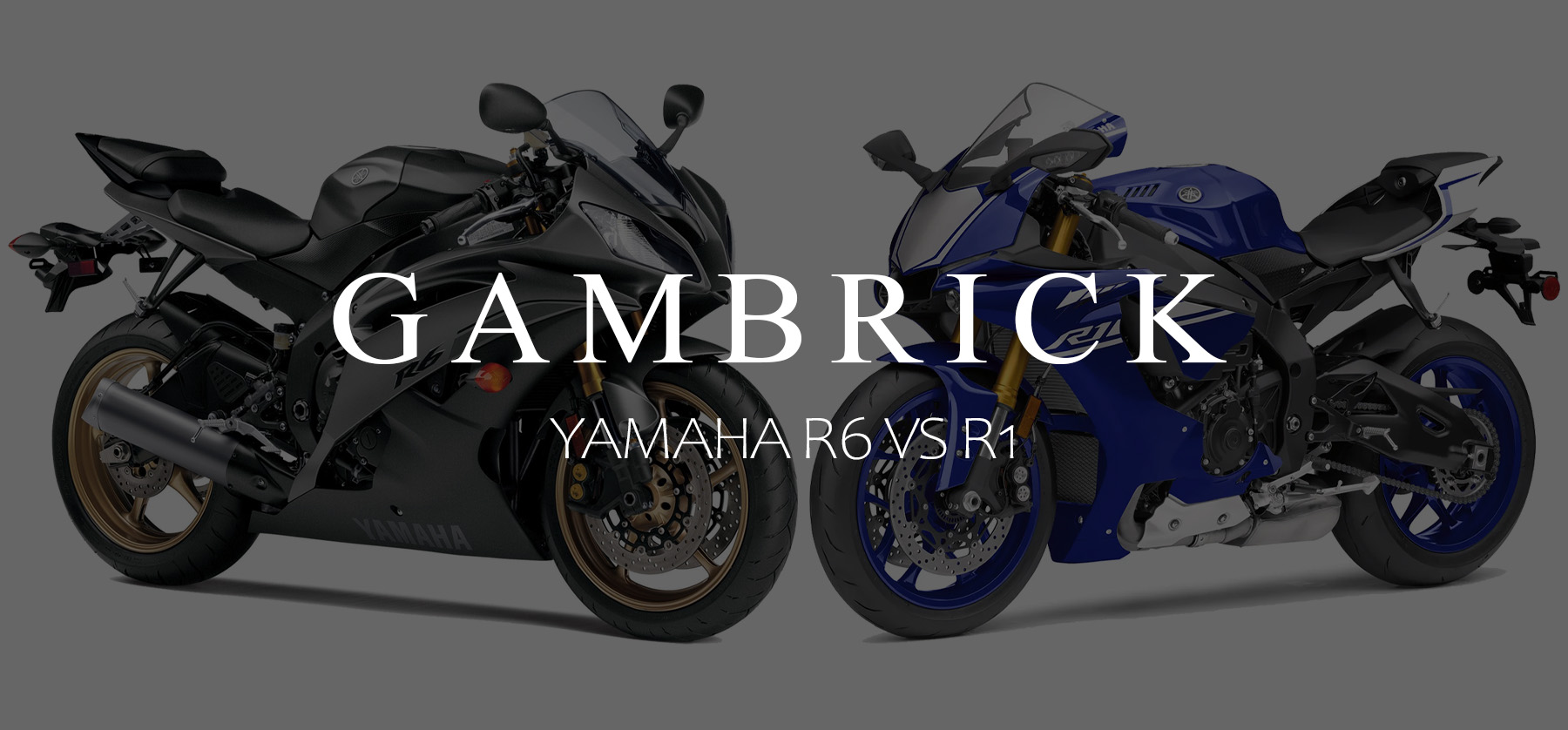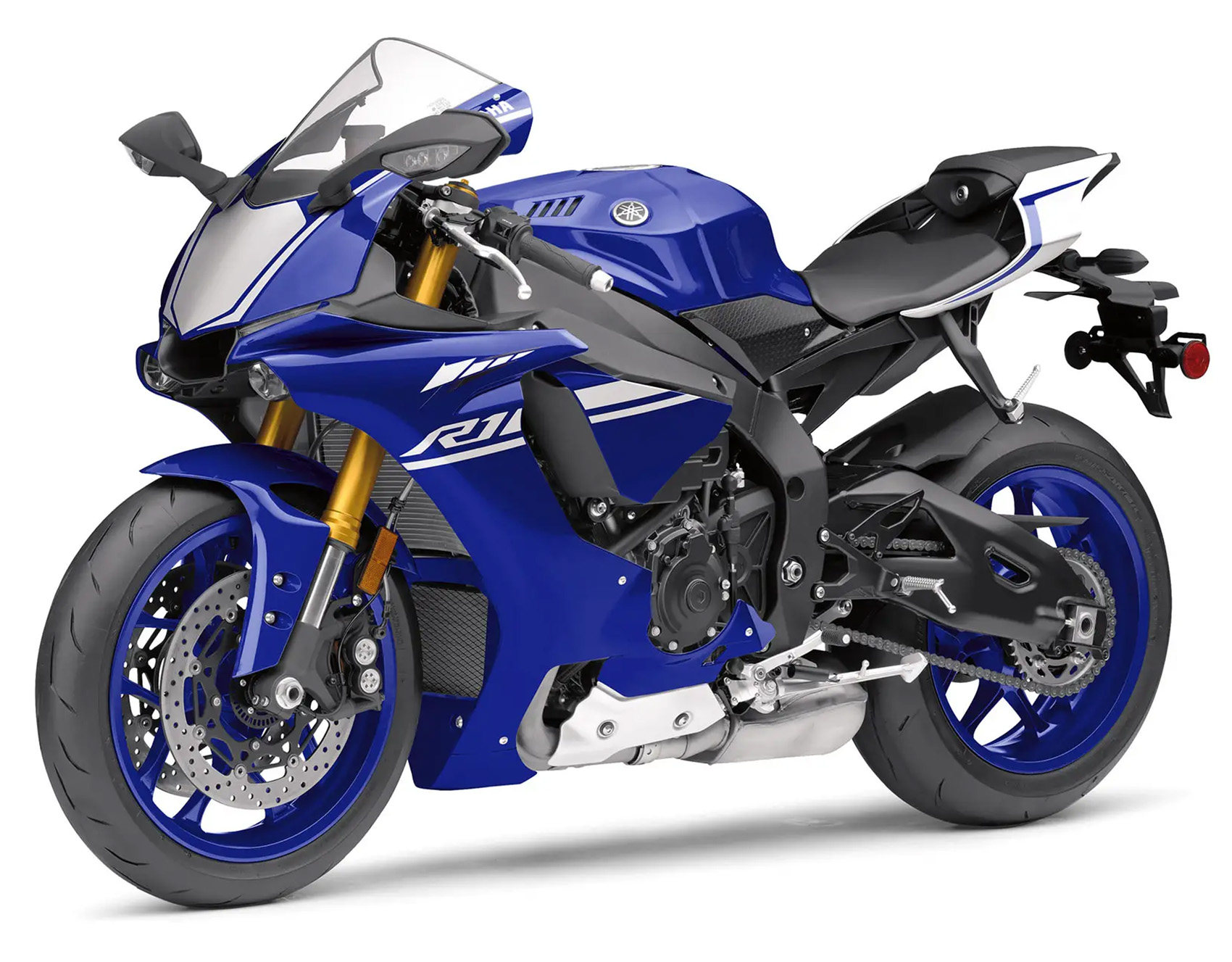Yamaha R6 vs R1
The main difference between the Yamaha R6 vs. the R1 is the engine. The R6 has a 599cc engine, while the R1 has a 998cc engine. Both models are high-performance sport motorcycles, but the R1 has more power and torque, which gives it a higher top speed and faster acceleration than the R6. But a larger engine also means more weight which effects how the R1 handles. The R6 is more agile and breaks faster than the R1, making it better for tight, technical tracks. On the other hand, the R1’s extra weight makes it more stable and planted at high speeds, making it better suited for longer, faster tracks. The extra weight also makes the R1 more comfortable to ride on regular roads.
- An R1 is more expensive and starts at about $17,999. The R6, while still a high-performance machine, is priced lower at around $12,699.
- Because the R1 has a bigger engine, it also has larger dimensions. Overall, it’s about 3cm longer and weighs about 9kg more. The R1 also comes with a slightly larger rear tire which helps put all that power down to the road.
- The bikes are very similar when it comes to looks but have slightly different styling cues, which helps set them apart.
I prefer the feel and extra weight of the R1 vs. the lighter and less powerful R6. I ride bikes on the road and not on track, so the added agility of the R6 is wasted on me. But the extra power and stability of the R1 are very nice, especially on long highways.
If you do the majority of your riding on regular roads, I’d choose the R1. However, if you like a more agile bike or want to save a few grand, go for the R6.
Comparing Yamaha YZF-R1 vs. YZF-R6: Speed, Performance, and Design
When it comes to speed, the Yamaha YZF-R1 and Yamaha YZF-R6 both offer exhilarating performance. However, the R1 has a bigger engine, so it can reach a blistering top speed of approximately 186 mph (299 km/h), while the R6 is not far behind, capable of achieving a top speed of around 160 mph (257 km/h).
The power delivery and feel of these two bikes are very different.
- R1 delivers its maximum torque of 83 lb.-ft @ 11,500 rpm and reaches its peak power output of approximately 197 HP @ 13,500 rpm.
- R6 produces its maximum torque of 45.5 lb.-ft @ 10,500 rpm and 118HP @ 14,500 rpm.
Despite its lower overall power output (approximately 118 HP), the R6 revs higher, reaching its peak power at 14,500 rpm. At what RPM the bikes produce power makes them feel very different. I prefer power at a lower RPM but some riders like a higher winding engine.
The R6 is more forgiving because it’s lighter and has more agility, particularly on a race circuit. However, the R1 has more power and weighs more, which is more comfortable on long drives and faster on straightaways.
Both motorcycles exhibit Yamaha’s racing DNA.
- The R1 is particularly sophisticated, and its design can be enhanced with various add-ons for personalization or different riding purposes.
- The R6 is recognized as a definitive sport bike, renowned for its stability in corners and nimble handling, making it a popular choice among track enthusiasts.
Both bikes come equipped with comfortable seating and responsive controls, making them a pleasure to ride, whether maneuvering through tight corners or accelerating on straights.
The choice between the Yamaha R1 and R6 largely depends on the rider’s preferred riding style and budget. Both motorcycles are high-quality machines, offering unique advantages and thrilling performance.
Difference Between The Yamaha R1 & R6
The biggest difference between the Yamaha R6 vs. the R1 is the engine. The R6 has a 599cc engine producing and 118HP @ 14,500 rpm 45.5 lb.-ft @ 10,500 rpm, while the R1 has a 998cc engine producing 197 HP @ 13,500 rpm and 83 lb.-ft @ 11,500 rpm.
Both bikes are high-performance motorcycles, but the R1 has more power and torque, which gives it a higher top speed and faster acceleration than the R6. But a larger engine means more weight, affecting how the R1 handles and brakes.
The R6 is more agile and breaks faster than the R1, making it more agile, but the R1’s extra weight and size make it more comfortable and faster.
| Features | Yamaha R6 | Yamaha R1 |
| Engine | 599cc engine producing 118HP @ 14,500 rpm and 45.5 lb.-ft @ 10,500 rpm and 118HP @ 14,500 rpm | 998cc engine producing 197 HP at 13,500 rpm and 83 lb.-ft @ 11,500 rpm |
| Top Speed | 160 mph (257 km/h) | 186 mph (299 km/h) |
| Dimensions |
|
|
| Price | $12,699 | $17,999 |
| Fuel Economy | Approximately 42 mpg | Approximately 34 mpg |
Because of the R1’s larger and more powerful engine, it’s a bigger, heavier bike. This changes the way it handle, feels, accelerates and brakes.
The engine produces power and torque at lower RPM which I prefer and I like the extra size and weight. But it’s not as nimble as the R6 and costs a lot more.
If you like highway driving on regular roads or want to ultimate performance bike, go with the R1. However, if you want a smaller, more agile bike that’s cheaper and better on gas, go with the R6. It’s also better in city driving if you live in or near one. I drove both bikes here in NYC and the R6 was more fun weaving in and out of traffic.
Which is More Expensive: R1 vs. R6?
The Yamaha R1 is more expensive than the R6. An R1 has a larger engine and more advanced features, starting at about $17,999. The R6, while still a high-performance machine, is priced lower at around $12,699. However, prices can vary based on factors like optional equipment, your dealer, and location.
No matter how you spec both bikes, a new R6 will never be more expensive or equal in price vs. a new R1. They’re simply a different class of bikes and priced accordingly.
Yamaha YZF-R1 vs YZF-R6
The Yamaha YZF-R1 and YZF-R6 are two of the most iconic motorcycles in Yamaha’s lineup. They’re both high-performance sports bikes but cater to different rider preferences and riding situations. The R1 is a liter-class bike designed for the most demanding performance situations, while the R6, a 600cc- class bike, offers an ideal blend of power and handling for both track and road use.
Let’s dive into a comparison of the two:
1. Engine & Transmission
The engine and transmission are where the Yamaha R1 and R6 differentiate the most. The R1 has a larger 998cc engine that makes 197HP @13,500 RPM vs. the R6’s 599cc engine that makes just 118HP @ 14,500 RPM. The R1 also makes more torque and has a higher top speed.
Both engines are fantastic but have a very different feel when riding. The R1 is noticeably more powerful and accelerates quicker in a straight line, but the R6 is lighter and very nimble. If I was racing around a track with lots of twists and turns, the R6 might be the better choice. But for riding on roads, I definitely prefer the more powerful R1.
I also really like how the R1 makes more power and torque at lower RPM, but I love the sound of the R6 engine at 14,000 RPM.
R1:
- Engine Type: 998cc, liquid-cooled, DOHC inline 4-cylinder; 16 valves
- Transmission: 6-speed; multi-plate slipper clutch with Yamaha Chip Controlled Shift (YCC-S)
- Max Power: Approximately 197 HP @ 13,500 RPM
- Max Torque: Approximately 83 lb.-ft @ 11,500 RPM
- Top Speed: Approximately 186 mph (299 km/h)
R6:
- Engine Type: 599cc, liquid-cooled, DOHC inline 4-cylinder; 16 titanium valves
- Transmission: 6-speed; multi-plate slipper clutch
- Max Power: Approximately 118 HP @ 14,500 RPM
- Max Torque: Approximately 45.5 lb.-ft @ 10,500 RPM
- Top Speed: Approximately 160 mph (257 km/h)
The R1 boasts a larger, more powerful engine and a more advanced transmission system. It’s designed for greater straight-line speed and power delivery. But the lighter R6 has more agility and is better on a track with lots of tight turns.
2. Performance
Clearly, the R1 is the more powerful machine, with significantly higher horsepower, torque, and top speed. However, the R6 is no slouch and offers considerable performance for its class.
R1:
- Max Power: Approximately 197 HP @ 13,500 RPM
- Max Torque: Approximately 83 lb.-ft @ 11,500 RPM
- Top Speed: Approximately 186 mph (299 km/h)
R6:
- Max Power: Approximately 118 HP @ 14,500 RPM
- Max Torque: Approximately 45.5 lb.-ft @ 10,500 RPM
- Top Speed: Approximately 160 mph (257 km/h)
3. Dimensions and Weight
The R1 is slightly larger and heavier, which translates to more stability at high speeds but less agility in tight corners. The R6, being lighter and more compact, is renowned for its handling and responsiveness.
On the regular roads, I prefer the extra power, weight, and stability of the R1. It has a great feel and is very comfortable. However, if I were on a track with tight corners or living in a city without long straightaways, I’d choose the R6 because it’s nimble and super fun to drive.
R1:
- Length: 81.7 in
- Width: 27.2 in
- Height: 45.3 in
- Seat Height: 33.7 in
- Wheelbase: 55.3 in
- Wet Weight: 448 lb.
R6:
- Length: 80.3 in
- Width: 27.8 in
- Height: 43.1 in
- Seat Height: 33.5 in
- Wheelbase: 54.1 in
- Wet Weight: 419 lb.
4. Fuel Economy
The R6 has a clear edge when it comes to fuel efficiency, making it a more economical choice for regular road use. However, actual mpg numbers depend on how you maintain your bike and how you drive. I’ve driven both, and the R6 had better fuel economy, but only by 2 mpg. On my road trips, I got about 33 mpg on the R1 and 37 on the R6.
The difference in my mpg numbers vs. Yamaha’s stated figures came down to my driving style. My tendency was to cruise more on the heavier but more powerful R1 while I pushed the lighter R6 a little harder on twisty roads.
R1:
- Estimated Fuel Economy: Approximately 34 mpg
R6:
- Estimated Fuel Economy: Approximately 42 mpg
While the Yamaha R1 and R6 are both high-performance motorcycles, they’re designed for slightly different purposes. The R1 is a top-of-the-line superbike meant for experienced riders looking for maximal power and advanced features.
In contrast, the R6, with its exceptional handling and lower power delivery, serves as a more manageable choice for less experienced riders or those who prioritize agility over raw power.
Both bikes are fantastic and top of their class, which is better depending on how and where you like to drive. They’re both great on the road or track, the R1 is better for straightaways and long rides, but I prefer the R6 for city driving or on twisting tracks.
Yamaha YZF-R1 vs YZF-R6: Which Bike is Better?
Choosing between the Yamaha YZF-R1 and YZF-R6 ultimately depends on the rider’s preferences, experience, and intended use of the motorcycle. Both motorcycles are high-performance machines, but they offer different strengths and weaknesses. The biggest thing to consider when comparing the two bikes is the size of the engine, which affects performance, handling, braking, weight, and price.
Performance and Handling
The R1, with its larger 998cc engine, outputs a staggering 197 HP and reaches a top speed of approximately 186 mph (299 km/h). It offers superior straight-line speed and power, making it suitable for experienced riders who enjoy high-speed rides or participate in track days.
I prefer the R1 on regular roads because it’s heavier, more stable, and makes power at a lower RPM. This makes the bikes feel more comfortable when cruising. However, you’ve still got tremendous power and great handling if you need it.
The R6, on the other hand, with a 599cc engine, produces 118 HP and can reach a top speed of 160 mph (257 km/h). It’s lighter weight and compact dimensions make it more agile, and its handling is more forgiving. This makes the R6 a great option for less experienced riders or those who value nimbleness and handling over raw power.
I prefer the R6 on tracks with lots of tight corners or for city driving, where you start and stop or turn frequently.
Comfort and Usability
While both bikes offer sport-focused ergonomics, the R1 is more comfortable for long rides because of its larger size and advanced suspension system. However, the R6, with its better fuel efficiency (approximately 42 mpg compared to R1’s 34 mpg) might be a more practical and economical choice for regular commuting.
The R6 is a little smaller and more nimble, which is actually noticeable when driving around NYC.
Price and Value
Price-wise, the R1 comes with a higher price tag, starting at about $17,999, reflecting its position as Yamaha’s flagship sportbike. The R6, is significantly cheaper and starts at around $$12,699, offering a more budget-friendly entry into the realm of high-performance sportbikes.
Conclusion: Which Bike Is The Better Buy?
Deciding which bike is the better buy between the Yamaha R1 and R6 isn’t a straightforward question, as it largely depends on individual preferences and requirements. The R1 is a top-of-the-line superbike packed with power and advanced features, ideally suited to experienced riders seeking maximal performance. In contrast, the R6 serves as a high-performing yet more manageable and economical choice, ideal for less experienced riders or those who prioritize agility and fuel efficiency.
As always, the best way to decide is to test ride both motorcycles, consider your riding style, and pick the one that best meets your personal preferences and budget.
I personally like the R1 better because I prefer a larger, heavier bike that makes power at lower RPM. It’s a more comfortable bike to ride on regular roads and long straightaways, but it’s a lot more expensive.
I prefer the R6 for city driving because it’s quick, light and nimble, and it’s a lot less expensive.
Yamaha YZF-R1 vs YZF-R6: Comparing Looks and Style
The Yamaha YZF-R1 and YZF-R6, while sharing common design language, exhibit distinctive aesthetic features that cater to different tastes and preferences. Both motorcycles, influenced by Yamaha’s YZR- M1 MotoGP® race bike, have an aggressive and aerodynamic design but with subtle differences that set them apart.
Yamaha YZF-R1 Style
The YZF-R1 is Yamaha’s flagship sportbike and its design reflects this status. Its larger size gives it a commanding road presence. It boasts a dual LED headlight configuration that gives it a unique, futuristic look, and the sharp, angular lines throughout its bodywork convey a sense of speed and aggression.
The R1 also features an under-tail exhaust, a design choice that’s not just aesthetically pleasing, but also aids in mass centralization for better handling.
The R1’s fairing and tail section are relatively broad and muscular, giving the bike a substantial, robust look. The layered fairing design, along with the air vent beside the headlights, not only adds to the bike’s visual appeal but also helps in managing engine heat. The R1 comes in a variety of color schemes,
allowing riders to choose according to their preference.
Yamaha YZF-R6 Style
The YZF-R6, while smaller, carries a sleek and compact design that many find more visually appealing. Its design is renowned for being one of the most aerodynamic in its class, with a low, pointed nose and a bubble windscreen designed to reduce wind resistance at high speeds.
The R6 sports a more traditional side-mounted exhaust and features a slim tail section, giving it a sleek, streamlined look. It has a distinctive, aggressive face characterized by slim, twin LED headlights and an aerodynamic front fairing. Like the R1, it also benefits from a variety of color schemes, from solid colors to the iconic Yamaha racing blue.
Conclusion: Which Bike Looks Better?
Choosing which bike is better in terms of looks and style is highly subjective as it largely depends on personal aesthetic preferences. The R1 delivers a commanding and robust presence with its muscular bodywork and aggressive design, while the R6 stands out for its compact, streamlined, and aerodynamic silhouette.
Both motorcycles exemplify Yamaha’s philosophy of blending style, performance, and technology. Therefore, the “better” bike in terms of look and style would be the one that best aligns with your personal taste and the image you want to project as a rider. Always remember, the best way to decide is to see both motorcycles in person and choose the one that appeals to you the most.
Personally, I like the R1’s looks and style better. I prefer a larger bike and a bigger engine which is hard to see in pictures but stands out when you see both bikes in person. I recommend visiting a Yamaha dealer that has both bikes in stock so you can see them side by side.
Yamaha YZF-R1 vs YZF-R6: Ride Quality and Experience
The Yamaha YZF-R1 and YZF-R6, despite sharing the Yamaha sportbike lineage, offer distinctly different riding experiences. Both are high-performance machines built to offer thrilling rides, but they each cater to different rider preferences and situations.
How Does The Yamaha YZF-R1 Ride?
The YZF-R1 is a liter-class bike, designed for extreme performance. With a 998cc, inline 4-cylinder engine that produces around 197 HP and 83 lb-ft of torque, the R1 delivers exhilarating acceleration and top-end power. Its advanced electronic control systems like Yamaha’s Chip Controlled Throttle (YCC-T) and Chip Controlled Shift (YCC-S) allow for precise control over the motorcycle’s immense power.
The R1’s ride is often described as raw and exhilarating. Its high power output demands respect, and riders often note that the bike encourages a more focused, aggressive riding style, particularly suitable for track days or high-speed runs.
In terms of ride quality, the R1 comes with a fully adjustable KYB® fork and a 4-way adjustable rear shock, providing excellent suspension performance. The seating position is aggressively sporty, which might be less comfortable for long rides but provides an immersive and engaging ride experience.
How Does The Yamaha YZF-R6 Ride?
The YZF-R6, on the other hand, is a 600cc-class bike that offers a more balanced blend of power and handling. It’s powered by a 599cc, inline 4-cylinder engine that outputs approximately 118 HP and 45.5 lb-ft of torque. Despite its lower power output compared to the R1, the R6 is renowned for its high-
revving engine and exciting power delivery.
The R6 as more manageable and forgiving than the R1. It’s lighter weight and compact size contribute to nimble handling and responsive feedback, making it an excellent choice for both track and road use. It excels in tight corners and technical sections, where agility and precision matter more than raw power.
The R6’s ride quality is sport-focused, with a fully adjustable KYB® fork and rear shock. Its seating position is also aggressive, but the overall setup is often considered slightly more comfortable for regular road use compared to the R1.
Conclusion: Which Bike Rides Better?
In conclusion, the YZF-R1 offers a high-adrenaline, high-speed ride experience suitable for experienced riders looking for maximal power and cutting-edge features. The YZF-R6 provides a more balanced, manageable ride, perfect for those who value nimbleness and precision handling over sheer power. The choice between the two would largely depend on the rider’s experience, preferred riding style, and the intended use of the motorcycle
Yamaha YZF-R1 vs. YZF-R6: Pros and Cons
Both the Yamaha YZF-R1 and YZF-R6 are superb motorcycles, but they have their own strengths and weaknesses. Below is a comparison of the pros and cons of both models.
Yamaha YZF-R1
Pros
- Powerful Performance: The R1’s 998cc engine outputs a staggering 197 HP, providing thrilling acceleration and top-end power. This makes the R1 an excellent choice for riders seeking extreme performance.
- Advanced Features: The R1 comes packed with cutting-edge technology, such as the Inertial Measurement Unit (IMU), Yamaha Ride Control (YRC), and a quick shifter, which offer precise control and customizable ride settings.
- Race-Inspired Design: With its aerodynamic styling, dual LED headlights, and under-tail exhaust, the R1 has a distinctive, aggressive look that matches its performance.
Cons
- Price: As Yamaha’s flagship sportbike, the R1 commands a premium price tag, which might be a deterrent for budget-conscious buyers.
- Less Forgiving: The R1’s high power output and aggressive riding position can be demanding, making it less suitable for novice riders or casual city riding.
- Lower Fuel Efficiency: The R1, with its powerful engine, consumes more fuel compared to the R6, leading to higher running costs.
Yamaha YZF-R6
Pros
- Agile Handling: The R6, with its compact size and lightweight, is known for its nimbleness and responsive handling, especially in corners and technical sections.
- More Forgiving: With its lower power output compared to the R1, the R6 is often considered more manageable and forgiving, making it a great choice for less experienced riders or those who prefer a more relaxed riding experience.
- Better Fuel Efficiency: The R6 offers better fuel efficiency than the R1, making it a more practical and economical choice for commuting.
Cons
- Lower Top Speed: Although the R6 is a high-performing machine, its top speed and overall power output are lower than the R1 due to its smaller engine.
- Fewer Advanced Features: While the R6 is still well-equipped, it does not have all of the cutting-edge features found on the R1, such as the IMU or the more advanced version of the YRC.
- Less Comfortable for Long Rides: Although the R6 has a slightly more relaxed riding position compared to the R1, some riders might still find it less comfortable for longer rides due to its focused, sporty ergonomics.
In conclusion, the R1 and R6 cater to different rider preferences and situations. The R1 is for experienced riders seeking maximal power and advanced features, while the R6 is for those who value nimbleness, manageability, and better fuel efficiency. As always, the best way to decide is to test ride both motorcycles and choose the one that best meets your personal preferences a
Yamaha YZF-R6 Motorcycle
The Yamaha YZF-R6, commonly referred to as the Yamaha R6, is a 600-class Super Sport motorcycle from Yamaha Motor Company. First introduced in 1999, the R6 has been a cornerstone in Yamaha’s lineup, known for its agile handling, impressive power delivery, and striking design.
Here’s a closer look at some of the key specifications of the Yamaha R6:
Model Year: 2023
Engine & Transmission
- Engine Type: 599cc, liquid-cooled, DOHC inline 4-cylinder; 16 titanium valves
- Bore x Stroke: 67.0mm x 42.5mm
- Compression Ratio: 13.1:1
- Transmission: 6-speed; multi-plate slipper clutch
- Final Drive: Chain
Performance
- Max Power: Approximately 118 HP @ 14,500 RPM
- Max Torque: Approximately 45.5 lb.-ft @ 10,500 RPM
- Top Speed: Approximately 160 mph (257 km/h)
Dimensions and Weight
- Length: 80.3 in
- Width: 27.8 in
- Height: 43.1 in
- Seat Height: 33.5 in
- Wheelbase: 54.1 in
- Wet Weight: 419 lb.
Brakes and Tires
- Front Brakes: Dual 320mm hydraulic disc; ABS
- Rear Brakes: 220mm hydraulic disc; ABS
- Front Tire: 120/70ZR17
- Rear Tire: 180/55ZR17
Fuel Economy
- Fuel Capacity: 4.6 gallons
- Estimated Fuel Economy: Approximately 42 mpg
Noteworthy Features
- Ride Modes: Yamaha’s Chip Controlled Throttle (YCC-T), Traction Control System (TCS), Quick Shift System (QSS), and D-Mode allow riders to customize their riding experience.
- Advanced Suspension: Fully adjustable KYB® fork and shock offer excellent road holding.
- Aerodynamic Bodywork: Inspired by Yamaha’s YZR-M1 MotoGP® race bike, the R6 offers low drag and superb high-speed stability.
The Yamaha R6 is a motorcycle that offers a fantastic blend of speed and agility with a sleek design. It’s a perfect choice for riders looking for a motorcycle that will perform on the street or track.
Yamaha YZF-R1 Motorcycle
The Yamaha YZF-R1, simply known as the Yamaha R1, is Yamaha’s flagship sport bike. Since its introduction in 1998, the R1 has been widely appreciated for its combination of power, agility, and advanced technology, making it one of the top choices in the liter-class category of motorcycles.
Let’s dive into the specific details of the 2023 Yamaha R1:
Model Year: 2023
Engine & Transmission
- Engine Type: 998cc, liquid-cooled, DOHC inline 4-cylinder; 16 valves
- Bore x Stroke: 79.0mm x 50.9mm
- Compression Ratio: 13.0:1
- Transmission: 6-speed; multi-plate slipper clutch with Yamaha Chip Controlled Shift (YCC-S)
- Final Drive: Chain
Performance
- Max Power: Approximately 197 HP @ 13,500 RPM
- Max Torque: Approximately 83 lb.-ft @ 11,500 RPM
- Top Speed: Approximately 186 mph (299 km/h)
Dimensions and Weight
- Length: 81.7 in
- Width: 27.2 in
- Height: 45.3 in
- Seat Height: 33.7 in
- Wheelbase: 55.3 in
- Wet Weight: 448 lb.
Brakes and Tires
- Front Brakes: Dual 320mm hydraulic disc; ABS
- Rear Brakes: 220mm hydraulic disc; ABS
- Front Tire: 120/70ZR17
- Rear Tire: 190/55ZR17
Fuel Economy
- Fuel Capacity: 4.5 gallons
- Estimated Fuel Economy: Approximately 34 mpg
Noteworthy Features
- Ride Modes: Yamaha’s Chip Controlled Throttle (YCC-T), Slide Control System (SCS), Lift Control System (LIF), Launch Control System (LCS), Quick Shift System (QSS), and Power Modes offer riders an array of customization.
- Advanced Suspension: Fully adjustable KYB® fork and shock for superior road grip.
- Aerodynamic Bodywork: Influenced by Yamaha’s YZR-M1 MotoGP® race bike, the R1 features an aggressive, aerodynamic design.
The Yamaha R1 continues to push the boundaries of performance, offering an exciting and highly sophisticated ride for experienced motorcyclists.
Summary: Yamaha R6 vs R1
The main biggest difference between the Yamaha R6 vs. the R1 is the engine. The R6 has a 599cc engine, while the R1 has a 998cc engine. Both models are high performance sport motorcycles, but the R1 has more power and torque, which gives it a higher top speed and faster acceleration than the R6. But a larger engine also means more weight which effects how the R1 handles.
The R6 is more agile and breaks faster than the R1, making it better for tight tracks. On the other hand, the R1’s extra weight makes it more stable and planted at high speeds, making it better for longer, faster tracks.
- The R1 is more expensive than the R6 due to its larger engine and higher performance capabilities.
- Because the R1 has a bigger engine, it also has larger dimensions. Overall, it’s about 3cm longer and weighs about 9kg more. The R1 also comes with a slightly larger rear tire which helps put all that extra power down onto the road where you need it.
- The bikes are very similar when it comes to looks but have slightly different styling cues, which helps set them apart.
I prefer the feel and extra weight of the R1 vs. the lighter and less powerful R6. I ride bikes on the road and not on track, so the added agility of the R6 is wasted on me. But the extra power and stability of the R1 are always noticeable, especially on long, straight highways.
If you do the majority of your riding on regular roads, I’d choose the R1. However, if you like windy tracks or want to save a few grand, go for the R6.
If you have any questions or comments about the Yamaha R6 vs. the R1, email any time.























